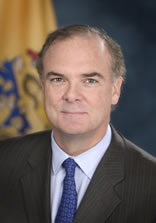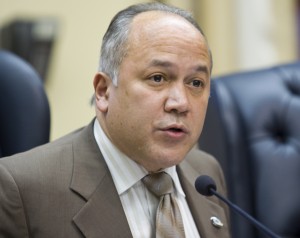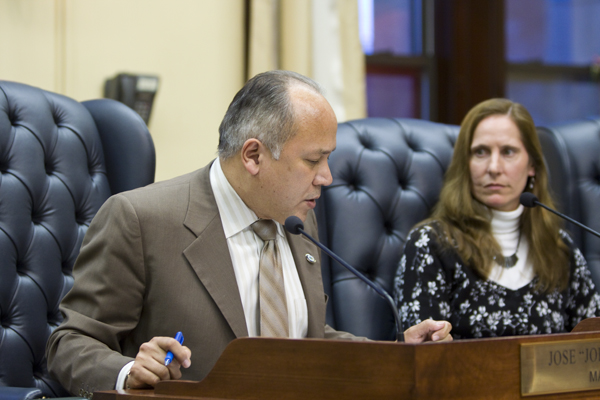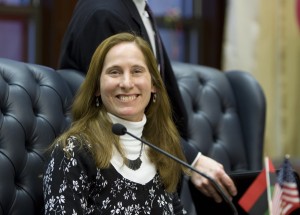[Update: 3/2/10 – read Martin interview by Todd Bates/Kirk Moore of APP, plus more in depth blog coverage by Bates]
We previously criticized DEP Commissioner nominee Bob Martin for failing to make a public statement of his vision for DEP and post his bio on the DEP website, as is traditional practice for incoming Commissioners.
That statement and bio are necessary parts of demonstrating leadership of the Agency and they set the stage for the qualifications, priorities, and policy agenda to be explored during Senate confirmation hearings. (read Martin interview here).
In the spirit of fairness, we are pleased to report that Martin finally has come out. Because we were harsh critics, we now post his bio and message to DEP employees, which was dated January 27, 2009, but just posted on the DEP web page (the DEP web page was updated/created on Feb. 24. A one month lag in posting is somewhat odd from a person who touts his IT experience. I guess his Senate confirmation hearing is scheduled. )
For now, I will only note disturbing policy themes and questionable priorities:
1. Martin’s bio stresses his experience in privatization and deregulation of public services and infrastructure (public utility/energy and water systems).
2. Martin’s bio provides no clear facts on exactly what his consulting experience is – I have read that Accenture, his firm, was known for downsizing and off shoring jobs. In my view, Martin’s bio does not demonstrate satisfaction of the statutory minimums required for the job, which are to be “qualified by training and experience to perform the duties of the office” as follows:
13 :1B-2. Commissioner of Conservation and Economic Development; appointment; term; salary
:1B-2. Commissioner of Conservation and Economic Development; appointment; term; salary
The administrator and head of the department shall be a commissioner, who shall be known as the Commissioner of Conservation and Economic Development, and who shall be a person qualified by training and experience to perform the duties of his office. The commissioner shall be appointed by the Governor, with the advice and consent of the Senate, and shall serve at the pleasure of the Governor during the Governor’s term of office and until the appointment and qualification of the commissioner’s successor.
[Note: The Department of Conservation and Economic Development was abolished an recreated as DEP on April 22, 1970 – the elimination of the economic development function is additional evidence in support of point #5 below]
3. Martin’s message to DEP employees repeats his emphasis on “robust cost/benefit analysis” (CBA is now mandatory for all DEP regulations/ under Executive Order #2)
Because regulations set the requirements for all permits issued by DEP, all environmental permits will be subject to CBA as well.
Cost benefit analysis is fraught with major controversies as a regulatory tool.
Worse, I have no idea what Martin means by the term “robust” – this is highly questionable, because DEP has just one economist on staff and he is not trained in CBA.
So, lack of DEP capacity likely will be used to open the door for industry conducted CBA and be used as a policy basis to scale back regulations.
To illustrate the likely abuse of CBA, on February 8, 2010, DEP Assistant Commissioner Nancy Wittenberg testified to the Senate Environment Committee that DEP would apply cost benefit analysis – after the fact – in making the Oyster Creek cooling tower final permit decision. The Oyster Creek Draft Surface Water Renewal Permit (pdf) issued by DEP in January did NOT include cost/benefit analysis, so I fail to see how DEP legally can do so after the fact. Wittenberg also confirmed that DEP would reply on “outside help“: (link to APP story)
The committee chairman, Sen. Bob Smith, D-Middlesex, had introduced legislation to require cooling towers before the DEP last month announced it would make that a requirement of a new discharge permit. Smith has promised in this legislative session to move on several proposals aimed at dealing with the bay’s ecological problems.
He asked Wittenberg how long the DEP will need to act on the plant permit.
“At least a year,” she said. Two public hearings are planned during the comment period that ends March 15, and then the DEP will need help from outside experts to conduct a cost-benefit analysis of the towers proposal, Wittenberg said.
“It will be a heavy lift for the department,” she added.
4. Martin’s message to DEP employees cites the “economic collapse” as a significant concern to him and DEP staff, yet he fails to note that the collapse was not created by DEP or environmental requirements, but by his private sector pals taking advantage of privatization and deregulation policies, while focused exclusively on economic issues and flawed tools, like cost benefit analysis..
5. Martin wants DEP “to play a key role in the economic growth of the state“. For now, I would just like to remind Martin and Senate Judiciary Committee members that promoting economic growth is NOT the statutory mission of DEP. Because so few seem to know what the DEP is supposed to do, here is DEP’s mission and powers, as established in DEP’s enabling legislation (note especially the lack of economic development powers):
13 :1D-9 Powers of department.
:1D-9 Powers of department.
 12.
12. The department shall formulate comprehensive policies for the conservation of the natural resources of the State, the promotion of environmental protection and the prevention of pollution of the environment of the State. The department shall in addition to the powers and duties vested in it by this act or by any other law have the power to:
The department shall formulate comprehensive policies for the conservation of the natural resources of the State, the promotion of environmental protection and the prevention of pollution of the environment of the State. The department shall in addition to the powers and duties vested in it by this act or by any other law have the power to:
 a.
a. Conduct and supervise research programs for the purpose of determining the causes, effects and hazards to the environment and its ecology;
Conduct and supervise research programs for the purpose of determining the causes, effects and hazards to the environment and its ecology;
 b.
b. Conduct and supervise Statewide programs of education, including the preparation and distribution of information relating to conservation, environmental protection and ecology;
Conduct and supervise Statewide programs of education, including the preparation and distribution of information relating to conservation, environmental protection and ecology;
 c.
c. Require the registration of persons engaged in operations which may result in pollution of the environment and the filing of reports by them containing such information as the department may prescribe to be filed relative to pollution of the environment, all in accordance with applicable codes, rules or regulations established by the department;
Require the registration of persons engaged in operations which may result in pollution of the environment and the filing of reports by them containing such information as the department may prescribe to be filed relative to pollution of the environment, all in accordance with applicable codes, rules or regulations established by the department;
 d.
d. Enter and inspect any property, facility, building, premises, site or place for the purpose of investigating an actual or suspected source of pollution of the environment and conducting inspections, collecting samples, copying or photocopying documents or records, and for otherwise ascertaining compliance or noncompliance with any laws, permits, orders, codes, rules and regulations of the department. Any information relating to secret processes concerning methods of manufacture or production, obtained in the course of such inspection, investigation or determination, shall be kept confidential, except this information shall be available to the department for use, when relevant, in any administrative or judicial proceedings undertaken to administer, implement, and enforce State environmental law, but shall remain subject only to those confidentiality protections otherwise afforded by federal law and by the specific State environmental laws and regulations that the department is administering, implementing and enforcing in that particular case or instance. In addition, this information shall be available upon request to the United States Government for use in administering, implementing, and enforcing federal environmental law, but shall remain subject to the confidentiality protection afforded by federal law. If samples are taken for analysis, a duplicate of the analytical report shall be furnished promptly to the person suspected of causing pollution of the environment;
Enter and inspect any property, facility, building, premises, site or place for the purpose of investigating an actual or suspected source of pollution of the environment and conducting inspections, collecting samples, copying or photocopying documents or records, and for otherwise ascertaining compliance or noncompliance with any laws, permits, orders, codes, rules and regulations of the department. Any information relating to secret processes concerning methods of manufacture or production, obtained in the course of such inspection, investigation or determination, shall be kept confidential, except this information shall be available to the department for use, when relevant, in any administrative or judicial proceedings undertaken to administer, implement, and enforce State environmental law, but shall remain subject only to those confidentiality protections otherwise afforded by federal law and by the specific State environmental laws and regulations that the department is administering, implementing and enforcing in that particular case or instance. In addition, this information shall be available upon request to the United States Government for use in administering, implementing, and enforcing federal environmental law, but shall remain subject to the confidentiality protection afforded by federal law. If samples are taken for analysis, a duplicate of the analytical report shall be furnished promptly to the person suspected of causing pollution of the environment;
 e.
e. Receive or initiate complaints of pollution of the environment, including thermal pollution, hold hearings in connection therewith and institute legal proceedings for the prevention of pollution of the environment and abatement of nuisances in connection therewith and shall have the authority to seek and obtain injunctive relief and the recovery of fines and penalties in a court of competent jurisdiction;
Receive or initiate complaints of pollution of the environment, including thermal pollution, hold hearings in connection therewith and institute legal proceedings for the prevention of pollution of the environment and abatement of nuisances in connection therewith and shall have the authority to seek and obtain injunctive relief and the recovery of fines and penalties in a court of competent jurisdiction;
 f.
f. Prepare, administer and supervise Statewide, regional and local programs of conservation and environmental protection, giving due regard for the ecology of the varied areas of the State and the relationship thereof to the environment, and in connection there with prepare and make available to appropriate agencies in the State technical information concerning conservation and environmental protection, cooperate with the Commissioner of Health and Senior Services in the preparation and distribution of environmental protection and health bulletins for the purpose of educating the public, and cooperate with the Commissioner of Health and Senior Services in the preparation of a program of environmental protection;
Prepare, administer and supervise Statewide, regional and local programs of conservation and environmental protection, giving due regard for the ecology of the varied areas of the State and the relationship thereof to the environment, and in connection there with prepare and make available to appropriate agencies in the State technical information concerning conservation and environmental protection, cooperate with the Commissioner of Health and Senior Services in the preparation and distribution of environmental protection and health bulletins for the purpose of educating the public, and cooperate with the Commissioner of Health and Senior Services in the preparation of a program of environmental protection;
 g.
g. Encourage, direct and aid in coordinating State, regional and local plans and programs concerning conservation and environmental protection in accordance with a unified Statewide plan which shall be formulated, approved and supervised by the department. In reviewing such plans and programs and in determining conditions under which such plans may be approved, the department shall give due consideration to the development of a comprehensive ecological and environmental plan in order to be assured insofar as is practicable that all proposed plans and programs shall conform to reasonably contemplated conservation and environmental protection plans for the State and the varied areas thereof;
Encourage, direct and aid in coordinating State, regional and local plans and programs concerning conservation and environmental protection in accordance with a unified Statewide plan which shall be formulated, approved and supervised by the department. In reviewing such plans and programs and in determining conditions under which such plans may be approved, the department shall give due consideration to the development of a comprehensive ecological and environmental plan in order to be assured insofar as is practicable that all proposed plans and programs shall conform to reasonably contemplated conservation and environmental protection plans for the State and the varied areas thereof;
 h.
h. Administer or supervise programs of conservation and environmental protection, prescribe the minimum qualifications of all persons engaged in official environmental protection work, and encourage and aid in coordinating local environmental protection services;
Administer or supervise programs of conservation and environmental protection, prescribe the minimum qualifications of all persons engaged in official environmental protection work, and encourage and aid in coordinating local environmental protection services;
 i.
i. Establish and maintain adequate bacteriological, radiological and chemical laboratories with such expert assistance and such facilities as are necessary for routine examinations and analyses, and for original investigations and research in matters affecting the environment and ecology;
Establish and maintain adequate bacteriological, radiological and chemical laboratories with such expert assistance and such facilities as are necessary for routine examinations and analyses, and for original investigations and research in matters affecting the environment and ecology;
 j.
j. Administer or supervise a program of industrial planning for environmental protection; encourage industrial plants in the State to undertake environmental and ecological engineering programs; and cooperate with the State Departments of Health and Senior Services, and Labor and Workforce Development, and the New Jersey Commerce Commission in formulating rules and regulations concerning industrial sanitary conditions;
Administer or supervise a program of industrial planning for environmental protection; encourage industrial plants in the State to undertake environmental and ecological engineering programs; and cooperate with the State Departments of Health and Senior Services, and Labor and Workforce Development, and the New Jersey Commerce Commission in formulating rules and regulations concerning industrial sanitary conditions;
 k.
k. Supervise sanitary engineering facilities and projects within the State, authority for which is now or may hereafter be vested by law in the department, and shall, in the exercise of such supervision, make and enforce rules and regulations concerning plans and specifications, or either, for the construction, improvement, alteration or operation of all public water supplies, all public bathing places, landfill operations and of sewerage systems and disposal plants for treatment of sewage, wastes and other deleterious matter, liquid, solid or gaseous, require all such plans or specifications, or either, to be first approved by it before any work thereunder shall be commenced, inspect all such projects during the progress thereof and enforce compliance with such approved plans and specifications;
Supervise sanitary engineering facilities and projects within the State, authority for which is now or may hereafter be vested by law in the department, and shall, in the exercise of such supervision, make and enforce rules and regulations concerning plans and specifications, or either, for the construction, improvement, alteration or operation of all public water supplies, all public bathing places, landfill operations and of sewerage systems and disposal plants for treatment of sewage, wastes and other deleterious matter, liquid, solid or gaseous, require all such plans or specifications, or either, to be first approved by it before any work thereunder shall be commenced, inspect all such projects during the progress thereof and enforce compliance with such approved plans and specifications;
 l.
l. Undertake programs of research and development for the purpose of determining the most efficient, sanitary and economical ways of collecting, disposing, recycling or utilizing of solid waste;
Undertake programs of research and development for the purpose of determining the most efficient, sanitary and economical ways of collecting, disposing, recycling or utilizing of solid waste;
 m.
m. Construct and operate, on an experimental basis, incinerators or other facilities for the disposal of solid waste, provide the various municipalities and counties of this State, and the Division of Local Government Services in the Department of Community Affairs with statistical data on costs and methods of solid waste collection, disposal and utilization;
Construct and operate, on an experimental basis, incinerators or other facilities for the disposal of solid waste, provide the various municipalities and counties of this State, and the Division of Local Government Services in the Department of Community Affairs with statistical data on costs and methods of solid waste collection, disposal and utilization;
 n.
n. Enforce the State air pollution, water pollution, conservation, environmental protection, solid and hazardous waste management laws, rules and regulations, including the making and signing of a complaint and summons for their violation by serving the summons upon the violator and thereafter filing the complaint promptly with a court having jurisdiction;
Enforce the State air pollution, water pollution, conservation, environmental protection, solid and hazardous waste management laws, rules and regulations, including the making and signing of a complaint and summons for their violation by serving the summons upon the violator and thereafter filing the complaint promptly with a court having jurisdiction;
 o.
o. Acquire by purchase, grant, contract or condemnation, title to real property, for the purpose of demonstrating new methods and techniques for the collection or disposal of solid waste;
Acquire by purchase, grant, contract or condemnation, title to real property, for the purpose of demonstrating new methods and techniques for the collection or disposal of solid waste;
 p.
p. Purchase, operate and maintain, pursuant to the provisions of this act, any facility, site, laboratory, equipment or machinery necessary to the performance of its duties pursuant to this act;
Purchase, operate and maintain, pursuant to the provisions of this act, any facility, site, laboratory, equipment or machinery necessary to the performance of its duties pursuant to this act;
 q.
q. Contract with any other public agency or corporation incorporated under the laws of this or any other state for the performance of any function under this act;
Contract with any other public agency or corporation incorporated under the laws of this or any other state for the performance of any function under this act;
 r.
r. With the approval of the Governor, cooperate with, apply for, receive and expend funds from, the federal government, the State Government, or any county or municipal government or from any public or private sources for any of the objects of this act;
With the approval of the Governor, cooperate with, apply for, receive and expend funds from, the federal government, the State Government, or any county or municipal government or from any public or private sources for any of the objects of this act;
 s.
s. Make annual and such other reports as it may deem proper to the Governor and the Legislature, evaluating the demonstrations conducted during each calendar year;
Make annual and such other reports as it may deem proper to the Governor and the Legislature, evaluating the demonstrations conducted during each calendar year;
 t.
t. Keep complete and accurate minutes of all hearings held before the commissioner or any member of the department pursuant to the provisions of this act All such minutes shall be retained in a permanent record, and shall be available for public inspection at all times during the office hours of the department;
Keep complete and accurate minutes of all hearings held before the commissioner or any member of the department pursuant to the provisions of this act All such minutes shall be retained in a permanent record, and shall be available for public inspection at all times during the office hours of the department;
 u.
u. Require any person subject to a lawful order of the department, which provides for a period of time during which such person subject to the order is permitted to correct a violation, to post a performance bond or other security with the department in such form and amount as shall be determined by the department. Such bond need not be for the full amount of the estimated cost to correct the violation but may be in such amount as will tend to insure good faith compliance with said order The department shall not require such a bond or security from any public body, agency or authority. In the event of a failure to meet the schedule prescribed by the department, the sum named in the bond or other security shall be forfeited unless the department shall find that the failure is excusable in whole or in part for good cause shown, in which case the department shall determine what amount of said bond or security, if any, is a reasonable forfeiture under the circumstances. Any amount so forfeited shall be utilized by the department for the correction of the violation or violations, or for any other action required to insure compliance with the order;
Require any person subject to a lawful order of the department, which provides for a period of time during which such person subject to the order is permitted to correct a violation, to post a performance bond or other security with the department in such form and amount as shall be determined by the department. Such bond need not be for the full amount of the estimated cost to correct the violation but may be in such amount as will tend to insure good faith compliance with said order The department shall not require such a bond or security from any public body, agency or authority. In the event of a failure to meet the schedule prescribed by the department, the sum named in the bond or other security shall be forfeited unless the department shall find that the failure is excusable in whole or in part for good cause shown, in which case the department shall determine what amount of said bond or security, if any, is a reasonable forfeiture under the circumstances. Any amount so forfeited shall be utilized by the department for the correction of the violation or violations, or for any other action required to insure compliance with the order;
 v.
v. Encourage and aid in coordinating State, regional and local plans, efforts and programs concerning the remediation and reuse of former industrial or commercial properties that are currently underutilized or abandoned and at which there has been, or is perceived to have been, a discharge, or threat of a discharge, of a contaminant. For the purposes of this subsection, “underutilized property” shall not include properties undergoing a reasonably timely remediation or redevelopment process; and
Encourage and aid in coordinating State, regional and local plans, efforts and programs concerning the remediation and reuse of former industrial or commercial properties that are currently underutilized or abandoned and at which there has been, or is perceived to have been, a discharge, or threat of a discharge, of a contaminant. For the purposes of this subsection, “underutilized property” shall not include properties undergoing a reasonably timely remediation or redevelopment process; and
 w.
w. Conduct research and implement plans and programs to promote ecosystem-based management.
Conduct research and implement plans and programs to promote ecosystem-based management.
 L.1970, c.33, s.12; amended 1975, c.33; 1981, c.446, s.1; 1983, c.38, s.1; 1984, c.5, s.1; 1997, c.278, s.26; 2007, c.246, s.2; 2007, c.288, s.6.
L.1970, c.33, s.12; amended 1975, c.33; 1981, c.446, s.1; 1983, c.38, s.1; 1984, c.5, s.1; 1997, c.278, s.26; 2007, c.246, s.2; 2007, c.288, s.6.
Here is Martin’s bio and statement to DEP employees, as posted on Feb. 24 on DEP website:
 Demonstrating his commitment to building a strong, experienced team, Governor Chris Christie nominated Bob Martin to serve as Commissioner of the Department of Environmental Protection.
Demonstrating his commitment to building a strong, experienced team, Governor Chris Christie nominated Bob Martin to serve as Commissioner of the Department of Environmental Protection.
An accomplished business and industry leader with recognized expertise in energy and utilities, he served as a key policy adviser throughout Governor Christie’s gubernatorial campaign. He assisted in shaping and drafting then-candidate Christie’s Energy Policy and Environmental Policy, and provided policy guidance on other major issues. In recent years, he also has served as a respected and trusted adviser, primarily in energy policy, to several other candidates for U.S. Senate, congressional and gubernatorial seats.
In 2008, he retired as a partner with Accenture LLP after more than 25 years. Accenture is the world’s largest business and technology consulting firm with more than 140,000 employees around the globe.
Highly experienced in consulting, he has achieved impressive results working with a variety of businesses and industries“ particularly energy and utility companies“ to improve efficiency and enhance performance in an increasingly competitive marketplace. He has expertise in all aspects of business and management consulting, including business strategy and planning, business transformation and re-engineering, IT strategy, systems implementation, and change management. He also has considerable experience in project management of large systems integration and in business re-engineering projects.
Acting Commissioner Martin also has extensive international experience. While living in England from 1991 to 1995, he worked with several large U.K. water and electric utilities as the companies privatized and the markets deregulated. He also spent significant time working with utility and energy companies throughout Europe and Canada.
Actively involved in the community, he was a candidate for State Senate in New Jersey’s 15th District in 2007. He formerly served as the Chairman of the Finance Committee for the Mercer County Republican Committee. He served on the Salvation Army Advisory Board of Greater New York from 2001 until January 2010, and as its Chairman from 2007 until January 2010. He served on the Princeton Healthcare System Foundation Board in 2008 and 2009. He also served on the Board of Trustees at the Chapin School in Princeton from 1996 to 2008, and on the Finance Advisory Committee for Hopewell Township from 2005 to 2007. He has been active in coaching youth soccer and lacrosse in Hopewell Valley for more than13 years.
Born and raised in Massachusetts, Acting Commissioner Martin earned a bachelor of arts in Economics and Sociology from Boston College in 1979 and an MBA from The George Washington University in 1982.
He and his wife, Brenda, have lived in Hopewell Township for more than 14 years. They have three children: Andrew, 24; Sara, 21; and Caroline, 12. Mrs. Martin is a teacher at the Cambridge School in Pennington.
Acting Commissioner Bob Martin’s January 27, 2010 message to DEP Employees
Dear DEP Team:
I want to send a quick note to all of you to introduce myself and to thank you all for a very warm welcome.
I am very honored to be your new Commissioner and to lead this wonderful organization. While I’ve only been here 6 days, I see many good things happening here, and a very talented group of professionals. At the same time, I do see things we can do better and must do better to fulfill Governor Christie’s agenda for action.
Like the Governor, I am personally committed to ensuring that the DEP protects New Jersey’s water, air, land and precious natural resources, and that we rapidly and predictably issue permits, clean up contaminated sites and ensure we protect our treasured open space for future generations. Additionally, our regulations and decisions need to be based on sound science, facts and a robust cost/benefit analysis. We will also continue to vigorously enforce the environmental laws of this state to protect the health and safety of all our citizens. At the same time, in the face of a collapsed economy, we need to play a key role in the economic growth of this State.
My style is to be open and honest and to work with all of you as a team. I want to empower decision making down through our chain of command and have all who come before us for service treated as valued customers.
I plan on walking through most of our locations over the next few weeks to meet as many of you as possible (I think I’m up to about 3 floors completed at 401 E. State) and will continue walking around our Trenton campus for an hour or so most days. A little later in my tenure I also plan to visit as many of our offices, parks and historic sites as possible located outside of Trenton.
There are a lot of very talented people here and I want you all to be part of the solution in improving our operations, efficiency and service to the public.
My commitment to all of you is that I will work as hard as I possibly can to make DEP a great place to work while we continue to protect the environment of this beautiful State. Most importantly, I will always listen and my door is always open.
Thanks!
Bob Martin
Acting Commissioner


 :1B-2. Commissioner of Conservation and Economic Development; appointment; term; salary
:1B-2. Commissioner of Conservation and Economic Development; appointment; term; salary 12.
12. Demonstrating his commitment to building a strong, experienced team, Governor Chris Christie nominated Bob Martin to serve as Commissioner of the Department of Environmental Protection.
Demonstrating his commitment to building a strong, experienced team, Governor Chris Christie nominated Bob Martin to serve as Commissioner of the Department of Environmental Protection.


 Some of those heroes gracing the perimeter of the empty Council chambers literally took the law into their own hands and fought for justice:
Some of those heroes gracing the perimeter of the empty Council chambers literally took the law into their own hands and fought for justice:



